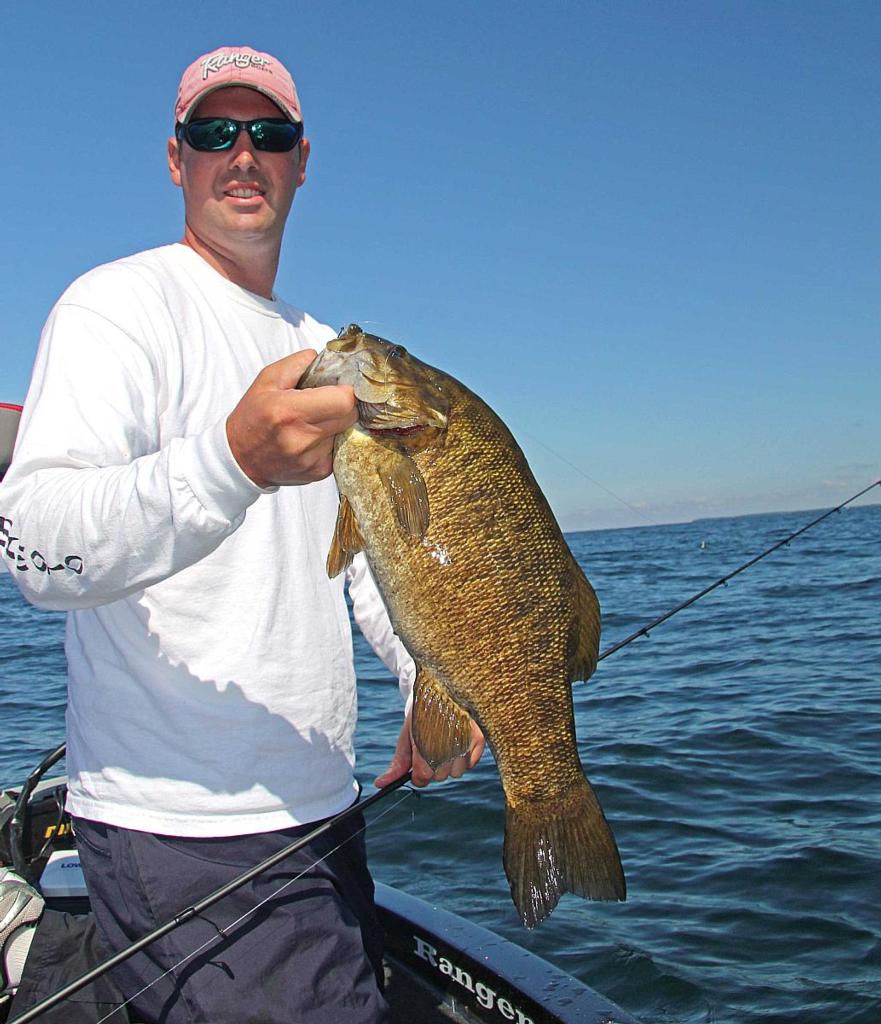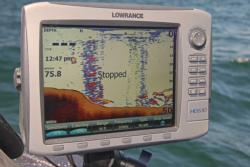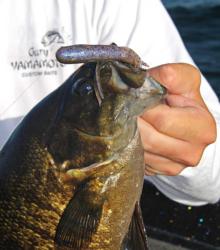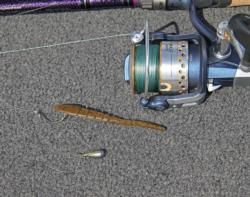Drop-Shotting with Joe Lucarelli

Angler: Joe Lucarelli
Fishery: 1000 Islands
Fishery Type: part of Lake Ontario; deep natural lake
Primary Forage: shad, gobies, darters
Date: July 27, 2011
Air Temperature: upper 70s
Weather: mostly sunny
Wind: northwest at 10 to 15 mph
Water Temperature: 74 to 75 degrees
Water Conditions: warm and rough
It’s easy to become overwhelmed by the vastness of it all when gazing across an expanse as large as Lake Ontario. Where do you find fish in all this water? EverStart Series Northern Division pro Joe Lucarelli showed me last summer. I watched the New Hampshire angler mentally box off a manageable section of this Great Lake, search a diverse range of habitat and dial in several quality catches through patience and discipline.
He gave me a solid lesson in drop-shotting big-water smallmouths, with a bonus lesson on how to break down seemingly boundless water.
Autumn Already?
We launch at 6:45 a.m. in the Chaumont Bay area just south of the site of an upcoming tournament in Clayton, N.Y. Lucarelli wants to take advantage of a convenient launch ramp close to the main road to see if by chance a typical fall pattern might have started early in the bay. We begin at the mouth and work grass beds in about 18 to 22 feet.
“Chaumont Bay is the only place with deeper grass in it,” Lucarelli notes. “Everything else on the main lake is just breaks and rocky bottom. In the fall, the yellow perch really crowd into that grass, and the smallmouth will come off the main lake, file into Chaumont and start gorging on all those perch.”
To give the fish different looks, Lucarelli works a drop-shot and I throw a Yamamoto tube in the gobylicious color. After about 30 minutes of testing different baits and probing, he determines that the deep grass deal isn’t happening.
Before departing the bay, Lucarelli pulls in close to a rocky shoreline and we work hard structure in 6 to 8 feet of water with a ghost-colored Lucky Craft Pointer 100 and a 1/2-ounce white/chartreuse Strike King Burner spinnerbait with gold willow blades. It looks like the perfect place to find fish, but the area is seemingly devoid of life. No bites – not even a follow – tell a clear tale.
“I just wanted to see if there was any bait up shallow,” Lucarelli says. “With a fishery like the 1000 Islands, there are so many fish in it that if I don’t even catch a 2-pounder, then that tells me that the shallow thing is not the deal.”
On the Rocks
 Satisfied that Chaumont Bay is not where he needs to be, Lucarelli runs out past the mouth and starts graphing main-lake rocks northwest of the bay in about 20 feet. At 7:30, my host suddenly perks up and quickly drops a marker as he exclaims, “Good morning!”
Satisfied that Chaumont Bay is not where he needs to be, Lucarelli runs out past the mouth and starts graphing main-lake rocks northwest of the bay in about 20 feet. At 7:30, my host suddenly perks up and quickly drops a marker as he exclaims, “Good morning!”
A large boulder appears on the depth finder. It rises several feet off the bottom, where a handful of heavy arches signal the presence of hefty smallmouths looking for breakfast. This, Lucarelli says, is much more encouraging than finding a spot with smaller fish.
“I want to see two to three good hooks [on the sonar], because the bigger the fish, the more color you have in the hook,” Lucarelli says. “If you see two or three hooks, there’s obviously more fish down there, you just didn’t see them when you drove over them. But if you see a ton of fish on the screen, there’s only so much bait for them to feed on, and they’ll probably be small.
“It’s like deer hunting, where you can only have a certain amount of deer in a square mile because there’s only so much for those deer to feed on before they run out of food. It’s the same thing with fish. I’d rather have a couple big smallmouths consuming bait than have 25 2 1/2-pounders mixing it up amongst themselves.”
Lucarelli is right on the money. He catches a 4-pounder on the drop-shot at 7:40, and I follow up with a 3-pounder about 10 minutes later.
Bait Is “Cool”
Main-lake spot No. 2 is a cluster of rocks in about 23 feet, but this time we only catch a “dink” on the drop-shot. During this lull, Lucarelli notes a distinct lack of activity; not even the pests are biting.
“I’m just not getting the goby bites here. That’s gotta mean something,” he says. “Those smallmouths are not out on the rocks because they think it’s cool. They’re there because they want to eat. So if the bait’s not there, then the fish aren’t going to be there.
“There’s nothing better than throwing a drop-shot and you feel the tap, tap, tap, tap, tap, tap, of a goby nipping at the lure, and all of a sudden the tapping stops and then you have that one big bite and the rod just loads up,” he says smiling. “That’s the gobies drawing attention to your bait, a smallmouth coming over to your bait, the goby getting out of there because he doesn’t want to get smoked and then you catching the smallmouth.”
Lucarelli says there are times you can leave the lure down there for the gobies to peck at it, and you won’t even have to set the hook when a smallmouth bites. They rod simply doubles over.
Unfortunately, I don’t get such a display of aggressive behavior on this spot.
Island Hopping
At around 8:45, we stow the rods and make a slow, plowing run through 4-foot swells across to Galloo Island, a few miles southwest of Chaumont Bay. Lucarelli does more looking and graphing. He also demonstrates the tremendous benefit of side-viewing sonar. As we idle across the island’s rocky outskirts in about 24 feet, he monitors his depth-finder unit with the beams set to view 80 feet out to each side.
“You can’t beat that side-imaging when it comes to finding fish on the Great Lakes,” he says. “These lakes are so vast that it saves you so much time. If you can determine if the fish are on rocks or other types of things, you can duplicate that over and over again.”
We spend a good bit of time idling and looking, with Lucarelli evaluating the merit of potential spots by their shows of bait and fish. At one point, an isolated cluster of boulders catches his attention. He marks a waypoint before finishing his present search, then we double back to inspect the spot. A few minutes pass and then Lucarelli’s rod doubles over with the day’s heaviest fish – a 5-pound football that bangs an Xzone Lures Slammer rigged on the drop-shot. The Slammer closely mimics the invasive round goby that smallies love. Fifteen minutes later, the Slammer produces a 4-pound, 4-ouncer.
“That little bait is just unreal, especially on those lakes that have gobies,” Lucarelli says. “In overcast conditions, I’ll go with green pumpkin so it profiles a little better. But when it’s sunny, you almost want your bait to have a little translucence, like the smoke color. You can always catch fish if you mark them on the screen and drop down on them, but you can tell if you have the right color because you’ll get a better fish to bite. If you drop down and you’re catching the 2-pounders, you know you’re not making those big fish want to eat.”
To help convince smallmouths it’s time to dine, Lucarelli dips the Slammers in JJ’s Magic garlic-scented dye. He dyes the lure’s head, not the tail, because he wants the fish to focus on the business end. Actually, Lucarelli says his jury’s still out on exactly how well garlic attracts fish. In his view, it’s not so much what the fish smells as what it doesn’t smell.
“I don’t know that garlic attracts the fish because they don’t eat anything with garlic in it, but it masks my scent on the bait,” he says. “In the morning, if you stop for fuel and you get some on your hands, it will transfer to the bait.”
Don’t Stop the Drop
 After a lot of looking in the Galloo area, we head back toward the mainland, eventually ending up back at the rocks outside Chaumont Bay around 2 p.m. In about 10 minutes, Lucarelli catches a 4-pounder and a 3 1/2-pounder on the drop-shot. Although I keep the tube wet between photos and note taking, Lucarelli says he greatly prefers the drop-shot over the tube on what is often a very harsh bottom environment. Zebra mussel shell beds can knick and damage the line when dragging tubes low to the bottom to imitate gobies.
After a lot of looking in the Galloo area, we head back toward the mainland, eventually ending up back at the rocks outside Chaumont Bay around 2 p.m. In about 10 minutes, Lucarelli catches a 4-pounder and a 3 1/2-pounder on the drop-shot. Although I keep the tube wet between photos and note taking, Lucarelli says he greatly prefers the drop-shot over the tube on what is often a very harsh bottom environment. Zebra mussel shell beds can knick and damage the line when dragging tubes low to the bottom to imitate gobies.
“When I used to fish here 10 years ago, you used to be able to catch fish on a tube,” he says. “I’m sure you still can, but the zebra mussels have gotten so bad now that you’re compromising your line when you’re dragging it. When you’re throwing that drop-shot you don’t have to worry about hurting your line and losing a fish.”
Lucarelli fishes his drop-shot on 15-pound-test braid with an 8-pound-test Sunline fluorocarbon leader, a No. 1 Gamakatsu drop-shot hook and a 3/8-ounce tungsten teardrop weight. He runs his hook point about halfway into the soft plastic and brings it out through the front of the head.
“When you reel in the drop-shot, the bait doesn’t twist and wreck your line [when rigged this way],” he says. “It comes straight back to you. That’s where your pull point needs to be. A lot of guys will put their hook right through the meat of the bait, but that allows your bait to twirl on the way up.”
That Sinking Feeling
We close out the day fishing the grass beds of Chaumont Bay, and Lucarelli offers a few more tips on his drop-shot tactics. He rigs his droppers from 6 to 18 inches long, depending on the habitat he’s fishing. In the grass of Chaumont Bay, the longer leader keeps the lure visible above the vegetation where smallies target shad, shiners and the like. When he’s trying to imitate the bottom-hugging goby, he shortens the leader.
“Gobies don’t have a swim bladder, so they just skitter along the bottom – they don’t ever suspend,” Lucarelli notes. “So it’s more of a natural presentation for that bait to be closer to the bottom, but smallmouths like to see stuff up a little bit.”
 Even within the extremes of leader length, Lucarelli likes to have room for minor adjustments. Sometimes lengthening or shortening an inch or so makes a difference. That’s why he leaves a foot or more of his tag end hang free past the drop-shot weight after hooking it on at the desired point. If he needs to adjust, he simply slides the weight up or down. Once he’s comfortable with the dropper length, he ties a little overhand knot beneath the weight’s clip, so that his line doesn’t slip loose.
Even within the extremes of leader length, Lucarelli likes to have room for minor adjustments. Sometimes lengthening or shortening an inch or so makes a difference. That’s why he leaves a foot or more of his tag end hang free past the drop-shot weight after hooking it on at the desired point. If he needs to adjust, he simply slides the weight up or down. Once he’s comfortable with the dropper length, he ties a little overhand knot beneath the weight’s clip, so that his line doesn’t slip loose.
Even with his drop-shot set up just the right way, we don’t get much action in the grass. It’s not long before we put the boat on the trailer and head home. Overall, Lucarelli spent most of his day with the big motor running and studying the graph. On the key rock piles where fewer fish showed up on the graph, he caught the best quality of fish. Where he didn’t catch them taught him just as much. N
Lessons Learned
• Finding a few good arches on an isolated rock pile is much more promising than finding loads of small marks.
• Dipping the head of a drop-shot lure in scent and/or dye directs the fish’s attention to the end with a hook in it.
• Minimize drop-shot spinning by inserting the hook into the lure’s body and poking the hook point out the front of the head.
• Make dropper adjustments easy by leaving a long tag end dangling below
the weight.